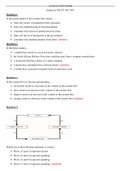ECS1601 TEST BANK
Edited by UK 071 950 7447,
Question 1
In the goods market of the circular flow model, ….
1) firms buy factors of production from consumers
2) firms buy finished products from households
3) consumers buy factors of production from firms
4) firms sell factors of production to the government
5) consumers buy finished products from firms. (correct)
Question 2
In the factor market, … .
1) a student buys lunch at a local university cafeteria.
2) the South African Defence Force buys machine guns from a weapons manufacturer
3) a retirement fund buys shares in a major company
4) a farmer buys farmland from a retiring farmer. (correct).
5) a welder buys a personal computer from an electronics store
Question 3
In the circular flow of income and spending, … .
1) investment results in a decrease in the volume of the income flow
2) taxes result in an increase in the volume of the income flow
3) imports result in an increase in the volume of the income flow
4) savings result in a decrease in the volume of the income flow (correct).
Question 4
Which one of the following statements is correct?
1) Flows (2) and (3) represent income.
2) Flows (2) and (4) represent spending.
3) Flows (1) and (2) represent spending.
4) Flows (1) and (3) represent spending. (correct)].
,Question 5
Which of the following is correct.
1) capital, wealth and income are stock variables, whereas investment and profit are flow variables
2) capital, wealth and gold reserves are stock variables, whereas investment, profit and loss are flow
variables. (correct)
3) investment, income and profit are stock variables, whereas capital, wealth and natural resources are flow
variables
4) capital, wealth and population size are stock variables, as are investment, profit and savings
Question 6
In the circular flow of income and spending, the main leakages are:
a) the foreign sector, the financial sector and taxes
b) imports, investments, bank withdrawals, off-shore shares and securities
c) imports, savings and taxes. (correct)
Question 7
In a mixed economy, the economic decisions of what to produce, how to produce it, and who will receive it are
made by … .
1) the government
2) consumers and firms
3) banks and stock markets
4) household, firms, government and the foreign sector. (correct).
5) banks and the government
Question 8
An example of a double coincidence of wants is … .
1) a car dealer who wants a TV finding an electronics store owner who wants money
2) a car mechanic who wants a TV finding an electronics store owner who wants a car repaired. (correct)
3) an electronics store owner who wants car repairs finding a car mechanic who wants money
4) All of the above.
Question 9
Money overcomes the problem of a double coincidence of wants through its function as a …
1) medium of exchange. (correct)
2) unit of account
3) standard of deferred payment
4) store of value
,Question 10
The demand for money curve is … because a lower interest rate,
1) upward-sloping; increases the opportunity cost of holding money
2) downward-sloping; increases the opportunity cost of holding money
3) upward-sloping; decreases the opportunity cost of holding money
4) downward-sloping; decreases the opportunity cost of holding money. (correct)
Question 11
A car-guard deposits his cash tips into his savings account. As a result of only this transaction, … .
1) M2 increases
2) M2 decreases
3) M3 remains constant. (correct)
Question 12
Assuming the economy is in equilibrium, the central bank sells bonds by means of open-market transactions.
How would this affect the equilibrium quantity of money and interest rates in the short run?
1) Quantity of money will go up and interest rates will go up.
2) Quantity of money will go up and interest rates will go down.
3) Quantity of money will go down and interest rates will go up. (correct)
4) Quantity of money will go down and interest rates will go down.
Question 13
Suppose that Sandton Bank has excess reserves of R800 and the reserve ratio is 20%. If Tshepo deposits R1 000
into his cheque account with Sandton Bank, and in turn Sandton Bank lends R600 to Mary, what is the maximum
that the bank can lend to Karabo?
1) R200
2) R800
3) R1 000 (correct)
4) R2 400
Question 14
Suppose the bank receives a cheque deposit of R300 and its excess reserves increase by R255, the required
reserve ratio must be … .
1) 5%
2) 15% (correct) (300-25)/300*100 = 15%
3) 25%
4) 65%
5) 38%
, Question 15
The …demand for money arises from the need to hold money as a medium of exchange. This demand for money
is a function of … .
1) precautionary; interest rates
2) transaction; national income (correct)
3) speculative; interest rates
4) precautionary; national income
5) transaction; interest rates
Question 16
If the economy is suffering from a recession, the SARB should apply … monetary policy by … interest rates.
1) expansionary; decreasing (correct)
2) expansionary; increasing
3) contractionary; decreasing
4) contractionary; increasing
Question 17
If the SARB institutes a policy to reduce inflation, which of the following is most likely to increase?
1) Taxes
2) Investments
3) government expenditure
4) interest rates (correct)
5) real GDP
Question 18
An appropriate measure of government’s involvement in economic activity is
1) the volume of government subsidies.
2) total government spending.
3) government’s share of total spending in the economy. (correct)
4) the growth of government spending.
Question 19
Which of the following statements regarding fiscal policy and the budget are correct?
a) Demand management only refers to fiscal policy.
b) If government spending should decrease and taxation should increase, a budget deficit is likely to occur.
c) When government plans to stimulate economic activity, it can increase its spending or reduce taxes.
(correct)




